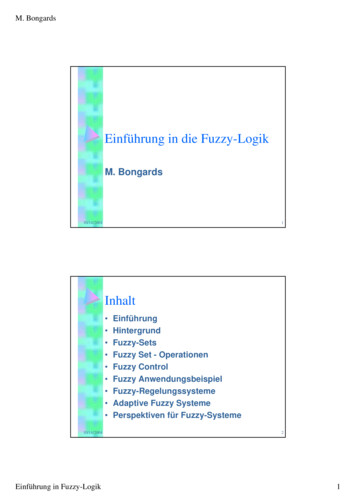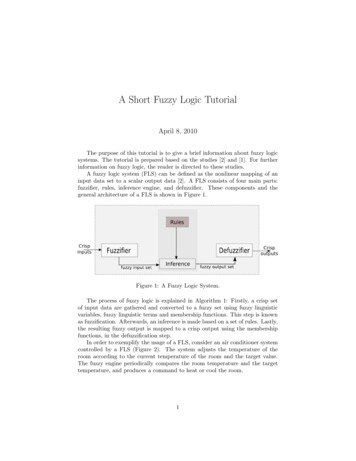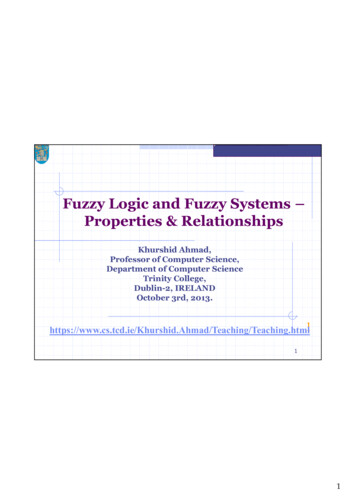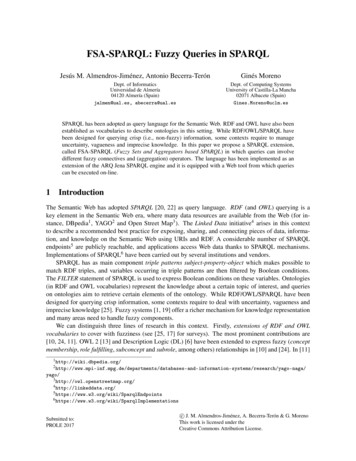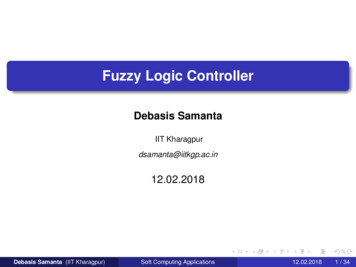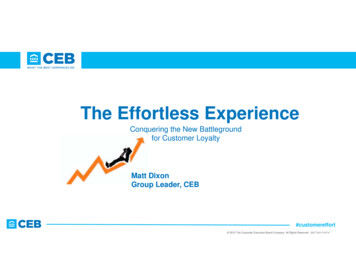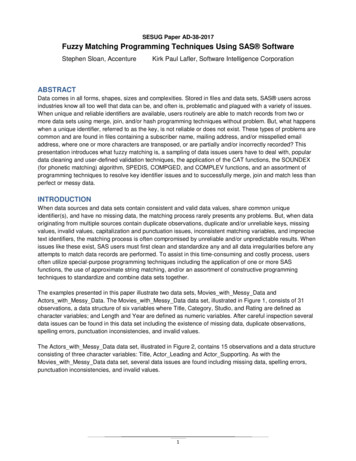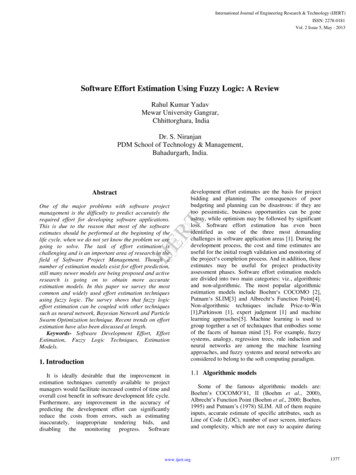
Transcription
International Journal of Engineering Research & Technology (IJERT)ISSN: 2278-0181Vol. 2 Issue 5, May - 2013Software Effort Estimation Using Fuzzy Logic: A ReviewRahul Kumar YadavMewar University Gangrar,Chhittorghara, IndiaDr. S. NiranjanPDM School of Technology & Management,Bahadurgarh, India.AbstractIJERTOne of the major problems with software projectmanagement is the difficulty to predict accurately therequired effort for developing software applications.This is due to the reason that most of the softwareestimates should be performed at the beginning of thelife cycle, when we do not yet know the problem we aregoing to solve. The task of effort estimation ischallenging and is an important area of research in thefield of Software Project Management. Though anumber of estimation models exist for effort prediction,still many newer models are being proposed and activeresearch is going on to obtain more accurateestimation models. In this paper we survey the mostcommon and widely used effort estimation techniquesusing fuzzy logic. The survey shows that fuzzy logiceffort estimation can be coupled with other techniquessuch as neural network, Bayesian Network and ParticleSwarm Optimization technique. Recent trends on effortestimation have also been discussed at length.Keywords- Software Development Effort, EffortEstimation, Fuzzy Logic Techniques, EstimationModels.development effort estimates are the basis for projectbidding and planning. The consequences of poorbudgeting and planning can be disastrous: if they aretoo pessimistic, business opportunities can be goneastray, while optimism may be followed by significantloss. Software effort estimation has even beenidentified as one of the three most demandingchallenges in software application areas [1]. During thedevelopment process, the cost and time estimates areuseful for the initial rough validation and monitoring ofthe project„s completion process. And in addition, theseestimates may be useful for project productivityassessment phases. Software effort estimation modelsare divided into two main categories: viz., algorithmicand non-algorithmic. The most popular algorithmicestimation models include Boehm„s COCOMO [2],Putnam„s SLIM[3] and Albrecht„s Function Point[4].Non-algorithmic techniques include Price-to-Win[1],Parkinson [1], expert judgment [1] and machinelearning approaches[5]. Machine learning is used togroup together a set of techniques that embodies someof the facets of human mind [5]. For example, fuzzysystems, analogy, regression trees, rule induction andneural networks are among the machine learningapproaches, and fuzzy systems and neural networks areconsidered to belong to the soft computing paradigm.1. IntroductionIt is ideally desirable that the improvement inestimation techniques currently available to projectmanagers would facilitate increased control of time andoverall cost benefit in software development life cycle.Furthermore, any improvement in the accuracy ofpredicting the development effort can significantlyreduce the costs from errors, such as estimatinginaccurately, inappropriate tendering bids, anddisabling the monitoring progress. Softwarewww.ijert.org1.1 Algorithmic modelsSome of the famous algorithmic models are:Boehm‟s COCOMO‟81, II (Boehm et al., 2000),Albrecht‟s Function Point (Boehm et al., 2000; Boehm,1995) and Putnam‟s (1978) SLIM. All of them requireinputs, accurate estimate of specific attributes, such asLine of Code (LOC), number of user screen, interfacesand complexity, which are not easy to acquire during1377
International Journal of Engineering Research & Technology (IJERT)ISSN: 2278-0181Vol. 2 Issue 5, May - 2013the early stage of software development life cycleprocess. Models based on historical data havelimitations. Understanding and the calculation usingthese models are difficult due to inherent complexrelationships between the related attributes, which areunable to handle categorical data as well as lack ofreasoning capabilities [6]. Besides, attributes andrelationships used to predict software developmenteffort those could change with the passage of timeand/or differ for software development environments(Srinivasan and Fisher, 1995). The limitations of thealgorithmic models led to the exploration of thenonalgorithmic techniques visualised through softcomputing philosophy.1.2 Non-Algorithmic models1.3.1Fuzzy Logic in Software Effort EstimationA fuzzy set theoretic model is a modelling constructfeaturing two main properties [13]: (1) It operates at alevel of linguistic terms (fuzzy sets), and (2) itrepresents and processes uncertainty. Fuzzy logic offersa particularly convenient way to generate a keenmapping between input and output spaces thanks to thenatural expression of fuzzy rules. In softwaredevelopment effort estimation, two considerationsjustify the decision of implement--ing a fuzzymodel:1) it is impossible to develop a precisemathematical model of the domain [14]; second,metrics only produce estimations of the realcomplexity. Thus, according to the previous assertions,formulating a tiny set of natural rules describingunderlying interactions between the software metricsand the effort estimation could effortlessly reveal theirintrinsic and wider sconceptualized and have been proposed to project costestimation. Software researchers have turned theirattention to new approaches those are based on softcomputing methodologies such as based on artificialneural networks and fuzzy logic models and geneticalgorithms based implementations. Neural networks areable to generalize from trained data set. A set oftraining data, a specific learning algorithm makes a setof rules that fit the data and fits previously unseen datain a rational manner as well. Some of the early worksshow that neural networks are adequately applicable tocost estimation phases as presented in the works ofVenkatachalam [7] and Krishna and Satsangi [8].Fuzzy logic offers a powerful linguistic representationthat is sufficiently accommodate the imprecision ininputs and outputs, while providing a more realisticknowledge based approach to model building.Contemporary research establishes to some extent thatfuzzy logic model achieved good performance index,being outperformed in terms of accuracy only by neuralnetwork model with considerably more input variables.Hodgkinson and Garratt in their works presented thatestimation by expert judgment was better than allregression based models [9].of variables to determine the confidence factor ormembership value (MV). Fuzzification allows inputand output to be expressed in linguistic terms.Inferencing involves defuzzification of the conditionsof the rules and propagation of the confidence factorsof the conditions to the conclusion of the rules.Defuzzification process refers to the translation offuzzy output into objective terms.A system based on Fuzzy Logic has a directrelationship with fuzzy concepts (such as fuzzy sets,linguistic Variables etc.) and fuzzy logic. The popularfuzzy logic systems can be categorised into three types:pure fuzzy logic systems, Takagi and Sugeno‟s fuzzysystem, fuzzy logic systems with fuzzification anddefuzzification [12]. Since most of the engineeringapplications produce crisp data as input and expectscrisp data as output, the last type i.e., fuzzy logicsystem with fuzzification and defuzzification is mostwidely used one and was first proposed by Mamdani. Ithas been successfully applied to a variety of industrialprocesses and consumer products [12].1.3 Fuzzy logic modelsA fuzzy model is used when the systems are notsuitable for analysis by conventional approach or whenthe available data is uncertain, inaccurate or vague [10].The fuzzy model uses the fuzzy logic conceptsintroduced by Lofti A. Zadeh [11]. Fuzzy reasoningconsists of three main components [12]: fuzzificationprocess, inference from fuzzy rules and defuzzificationprocess. Fuzzification process is where the objectiveterm is transformed into a fuzzy concept. Themembership functions are applied to the actual valueswww.ijert.org2. Review of Software Estimation Based OnFuzzy Logic TechniquesDuring the last decade, many methodologies have beendeveloped in the areas of software cost estimation forimproving estimation accuracy. Here we present atabular view (Table 1) of works of various authors onsoftware development effort estimation based on FuzzyLogic techniques and concepts.1378
International Journal of Engineering Research & Technology (IJERT)ISSN: 2278-0181Vol. 2 Issue 5, May - 2013Table 1. Research on Software Development Effort Estimation Based On Fuzzy Logic Techniques.YearRelated Work DoneResult Reported1992Introduced the f-COCOMO modelwhich applied Fuzzy Logic to theCOCOMO model for software effortestimation.Since there was no comparison ofresults between the f-COCOMO andother effort estimation models in theirstudy the estimation capability of theirmodel is unknown.S. Kumar, B.A.Krishna and P.S.Satsangi [16]1994Had applied fuzzy logicinPutnam‘s manpower buildup index( n 64 different fuzzy associativememory (FAM) rules.The w o r k s h o w e d h o w fuzzyF A M ’ s can be effectively applied tothe domain of softwareprojectmanagementandcontrol for theestimation of the MBI.Gray andMacDonell [17]1997Compared Function Point Analysis,Regression techniques, feedforwardneural network and fuzzy logic insoftware effort estimation.Their resultsshowed that fuzzylogic model achieved good performance,being outperformed in terms of accuracyonly by neural network model withconsiderably more input variables.Gray andMacDonell [18]1999DevelopedFULSOME(FuzzyLogic for Software Metrics) which is aset of tools that helps in creating fuzzymodel.Theautomaticallygeneratedfuzzymodel performsacceptablywhencompared to regression-based models.J. Ryder [19]1998Researched on the application offuzzy logic to COCOMO and FunctionPoints models.Result showed Fuzzy Logic is good atmaking effort estimations.P. Musflek, W.Pedrycz, G. Succiand M. Reformat[20]2000Worked on fuzzifying basic COCOMOmodelwithoutconsideringtheadjustment factor.In their simple fCOCOMO model, the size input into theCOCOMO model is represented by afuzzy set, while a and b coefficients arecrispvalues.Besidesthesize,augmented f- COCOMO also fuzzifiedboth the coefficients related to thed e v e l o p m e n t mode.Triangular membership functions are used in thisstudy.They concluded that (a) fuzzy sets helparticulate the estimates and theiressence (by exploiting fuzzy numbersdescribed by asymmetric membershipfunctions) and (b) they generate afeedback as to the given uncertainty(granularity) of the results.A.Idri, A. Abran,L. Kjiri [21]2000ProposedfuzzyintermediateCOCOMO'81. The FLM is based upontrapezoidal membership functions. Thedataset is randomly generated andcomparedwithactualdataofCOCOMO’ 81. The effort multiplier foreach cost driver is obtained from fuzzyValidation results showed that thefuzzy intermediate COCOMO‘81 cantolerate imprecision in its input (costdrivers) and generate more gradualoutputs.Thusfuzzy intermediateCOCOMO‘81 is less sensitive to thechanges in the inputs as comparedFei Z and Liu X[15]IJERTAuthorswww.ijert.org1379
International Journal of Engineering Research & Technology (IJERT)ISSN: 2278-0181Vol. 2 Issue 5, May - 2013set, enabling its gradual transitionfromone interval to a contiguousinterval such as from high to veryhigh).to intermediate COCOMO‘81.2002Proposed a n approach based onfuzzy logic named Fuzzy Analogy. Itsdataset is that of COCOMO 81.Takingintoaccounttheirresults,they suggested the following ranking of thefour techniques in terms of accuracy andadequacy to deal with linguistic values: 1.Fuzzy Logic, 2. Fuzzy intermediateCOCOMO‘81, 3.Classical intermediateCOCOMO‘81, and 4. Classical Analogy.Huang, X.,Capretz. L.F.,Ren, J., Ho. [23]2003Proposed a model combining fuzzylogic and neural networks. Thed a t as et was obtained from theoriginal COCOMO (1981).The results of the fuzzy logic modelwere better than those of the COCOMOequations. The FLMwasbasedupon triangular membership functions.The main benefit of this model is itsgood interpretability by using the fuzzyrules.M.O. Saliu, M.Ahmed and J.AlGhamdi. [24]2004They fuzzyfied the two differentportions of the intermediate COCOMOmodel i.e. nominaleffort estimationand the adjustment f a c t o r . Theyp r o p o s e d a f u z z y logic frameworkfor effort prediction by integrating thefuzzified nominal effort and thefuzzifiedeffortmultipliersoftheintermediate COCOMO model.This approach is able to deal withuncertainty, provides transparency onprediction rationale through rules,incorporate experts knowledge in thedefinition of membership functions andrules, as well as adaptable to new databychangingtheparametersofmembership functions.Ahmed, M.A.,Saliu, M.O. andAlGhamdi, J. [25]2004Presented a FLM based upontriangular membership functions.The datasetfor validatingtheFLM was (a) generated randomlyand (b) that of COCOMO 81 wasused.Results showed that the FLM wasslightly better than COCOMO equations.In addition, they reported promisingexperimentalsummary resultsinspite of the little background knowledgeof the rule base and training data.Crespo, F.J.,Sicicila, M.A.,Cuadrado, J.J.[26]2004Explored fuzzy regression techniquesbased upon fuzzification of inputvalues. Project database of COCOMO81 are used.Fuzzy regression is able to obtainestimation models with similar predictiveproperties than existing basic estimationmodels.M.R. Braz, S.R.Vergilio. [27]2004Applied Fuzzy Logic for effortestimation of object-oriented software.FUSP(Fuzzyuse casesizepoints)metricallowsgradualclassifications of use case sizepoints in the effort estimation by usingfuzzy numbers.Results showedbetter than USP.Xu and2004Presented a fuzzyidentificationcost estimation modelling technique todealwithlinguisticdata,andIt was observed that the fuzzyidentification model provided significantlybetter cost estimations than the threeIJERTA. Idri, and A.Abran[22]www.ijert.orgthatFUSPfares1380
International Journal of Engineering Research & Technology (IJERT)ISSN: 2278-0181Vol. 2 Issue 5, May - 2013Khoshgoftaar [28]COCOMO‘81 models.2006Carried out a study to compare personalFuzzy Logic Systems (FLS)withlinearregression using evaluationcriteria which is based upon ANOVAof MRE and MER, as well asMMRE, MMER and pred(25)Results show that a FLS can be usedas an alternative for estimating thedevelopment effort at personal level.Moon Ting Su,Teck Chaw Ling,Keat KeongPhang, CheeSun Liew andPeck Yen Man[30]2007Proposed an enhanced fuzzy logicmodel for the estimation of softwaredevelopment effort. The model Estimation(FLECE)possessessimilar capabilities as the previousfuzzy logic model. In addition to that,the enhancements done in FLECEimproved the empirical accuracy ofthe previous model in terms of MMRE(Mean Magnitude of Relative Error)and threshold- oriented predictionmeasure or prediction quality (pred).The analysis of the results shows thatFLECE is able to obtain more accurateresults in the estimation of softwaredevelopmenteffort whencomparedto the previous fuzzy logic model.Hence, the enhancements to FLECEare truly useful and had given betterperformance to the model.Venus Marza,Amin Seyyedi,and LuizFernandoCapretz[31]2008Hybrid neuro-fuzzy technique is usedfor development time and is validatedwith gathered data.The results showed that neuro-fuzzysystem is much better than two othermentioned methods (fuzzy logic andneural network separately).Hence, Inorder to achieve more accurateestimation, several techniques maybecombined.Parvinder S.Sandhu, PorushBassi, andAmanpreet SinghBrar[32]2008Neuro-Fuzzy technique is used forsoftware estimation of NASA softwareproject data and performance of thedeveloped models are compared with theHalstead, Walston-Felix, Bailey-Basiliand Doty ModelsThe performance of the Neuro-fuzzybased effort estimation Model and theother existing Halstead Model, WalstonFelix Model, Bailey-Basili Model and DotyModel models is compared for effortdataset .The results show that the Neurofuzzy system has the lowest MMRE andRMSSE values.L.M.Cuauhtemoc,Y.M. Cornelio andG.T.Agustin.[29]ImanAttarzadehand Siew2009IJERTautomaticallygeneratefuzzymembership functions and rules. Acase of study based on theCOCOMO‘81 database compared theproposed model with all threeCOCOMO‘81models(basic,intermediate and detailed).Proposed an enhanced Fuzzy Logicapproach for theestimationofsoftware development effort.www.ijert.orgResults s h o w e d t h a t t h e v a l u e o fM M R E applying their Fuzzy Logic modelwas substantially lower than MMRE values1381
International Journal of Engineering Research & Technology (IJERT)ISSN: 2278-0181Vol. 2 Issue 5, May - 2013Hock Ow[33]as calculated by applying other Fuzzy Logicmodels.The proposed work is based onCOCOMO dataset and the experimentalpart of the study illustrates the approachusing Gaussian membership functionResult showed the proposed model givesmoreprecise result than that of using theTMF. Thus by using GMF, the accuracy ofeffort estimation can be improved and theestimated effort can be very close to the actualeffort.2010Proposed an approach combining theneuro-fuzzy technique and the SEERSEM effort estimation algorithm andevaluate the prediction performance ofthe proposed neuro-fuzzy model withSEER-SEM in software estimationpractices.Results shows that that combining theneuro-fuzzy model with the SEER-SEMeffort estimation model produces uniquecharacteristicsandperformanceimprovements. Results also proves that theproposed neuro-fuzzy structure can be usedwith other algorithmic models besides theCOCOMO model.Abou BakarNauman,RomanaAziz[36]2011This paper proposes a simple BayesianNetwork (BN), based on classificationapproach. The classes of ranges of sizevalue are distributed with help offuzzification to distribute the probabilityof crisp value.The proposed model shows two specificachievements. 1). Model shows that a smallerBayesian network can be developed toachieve intelligent effort estimates. 2). Theclassifications of sizes can be managed withthe help of fuzzy logic.Prasad ReddyP.V.G.D, SudhaK. R, RamaSree [37]2011Software development effort predictedusing Fuzzy Triangular MembershipFunctionandGBellMembershipFunction is implemented and comparedwith COCOMO using NASA93 dataset.Results shows that software effort estimationusing Fuzzy method with TMF (triangularmembership function) isA.BalaKrishna,T.K.RamaKrishna[38]2012The propsed work is to employ ParticleSwarm Optimization for tuning the effortparameters, fuzzy logic for reducinguncertainty in input and test itssuitability for software effort estimation.This methodology is then tested usingNASA dataset provided by Boehm. Theresults are then compared with themodels such as Baily-Basili, Alaa F.Sheta, and Harish models.Results shows that the proposed modelreduce the uncertainty in the input sizes byusing fuzzy logic and by lining theparameters of the cost model using PSOwith inertia weight in order to generate anoptimal result. The model was proved to beefficient on the basis of VARE, MARE andVAF after comparing with the models suchas Baily-Basili, Alaa F. Sheta, and Harishmodels.Wei Lin Du,Danny Ho, LuizFernandoCapretz[35]IJERT2009Ch. SatyanandaReady, KVSVNRaju[34]www.ijert.orgbetter than Fuzzy method using GBellMF orIntermediate COCOMO. It is not possible toevolve a method, which can give 100 % VAF.By suitably adjusting the values of theparameters in FIS we can optimize theestimated effort.1382
International Journal of Engineering Research & Technology (IJERT)ISSN: 2278-0181Vol. 2 Issue 5, May - 20133.Conclusion4. hough many researchers contributed on cost/effortestimation, still many issues on cost/effort estimationremain unresolved. In this paper we presented a reviewon the Fuzzy Logic applications in Softwaredevelopment effort estimation models development.We also discussed the various advantages of FuzzyLogic for developing prediction models. In order toachieve more accurate estimation, voting the estimatedvalues of several techniques and combine their resultsmaybe be useful. Further results can explore using fourfuzzy logic membership functions Fuzzy TriangularMembership Function, GBell Membership Function,Gauss Membership Function and TrapezoidalMembership Function and their results will becompared with other estimation models and actual dataset of the project. The fuzzy logic models for effortestimation can be deployed on COCOMO IIenvironment for creating an appropriate expert systemfor providing required information for developingfuzzy sets and an appropriate rule base.International Conference on Software Engineering andApplications – SAE.,. pp: 401-406.R. Babuska, Fuzzy Modeling for Control, KluwerAcademic Publishers, Dordrecht, 1999.Lofti Zadeh, A., 1994. Fuzzy Logic, Neural Networksand Soft Computing, Communication of ACM 37(3):77-84.Lofti Zadeh, A., 2001., The Future of Soft Computing,In Joint 9th IFSA World Congress and 20th NAFIPSInternational Conference, Vancouver, Canada.Pedrycz, W., Gomide, F., 1998. An Introduction toFuzzy Sets. The MIT Press.Lewis, J.P., 2001. Large limits to softwareestimation. ACM Software Engineering Notes 26 (4), 54–59.Fei Z, Liu X, f-COCOMO Fuzzy Constructive CostModel in Software Engineering in IEEE internationalconference on Fuzzy systems, 1992, pp. 331-337.S. Kumar, B.A. Krishna, and P.S. Satsangi,"Fuzzy systems and neural networks in softwareengineering project management‖. Journ- al ofApplied Intelligence, Vol. 4, 1994, pp. 31-52.A. R. Gray, S. G. MacDonell, Applications of FuzzyLogic to Software Metric Models for DevelopmentEffort Estimation‖. Fuzzy Information Processing Society 1997 NAFIPS„ 97, Annual Meeting of the NorthAmerican, 21 – 24 September 1997, pp. 394 – 399.S. G. MacDonell, A. R. Gray, J. M. Calvert.FULSOME: Fuzzy Logic for Software Metric Practitioners and Researchers in Proceedings of the ssingICONIP„99,ANZIIS„99,ANNES„99 and ACNN„99, Perth, Western Australia,IEEE Computer Society Press, 1999, pp.308-313.J. Ryder, Fuzzy Modeling of Software Effort Predic- tionin Proceeding. of IEEE Information TechnologyConference, Syracuse, NY, 1-3 Sept 1998, pp: are Cost Estimation with Fuzzy Models,Applied Computing Review, Vol. 8, No.2, 2000, pp.24-29.A. Idri, A. Abran, L. Kjiri. „COCOMO cost modelusing Fuzzy Logic‖, 7th International Conference onFuzzy Theory & Techniques, 27 Feb – 3 March 2000,Atlantic City, New Jersey.A. Idri, A. Abran,, T.M. Khoshgoftaar. Estimatingsoftware project effort by analogy based on linguisticvalues‖ in.Proceedings of the Eighth IEEE Symposium onSoftware Metrics, 4-7 June 2002, pp. 21 – 30.Huang, X., Capretz. L.F., Ren, J., Ho, D.A., NeuroFuzzy Model for Software Cost Estimation. In:Proceedings of the Third International Conference onQuality Software, 2003.M.O. Saliu, M. Ahmed and J. AlGhamdi. Towardsadaptive soft computing based software effortprediction‖ Fuzzy Information, 2004. ProcessingNAFIPS '04. IEEE Annual Meeting of the NorthAmerican Fuzzy Information Processing Society, 2730 June 2004, Vol.1, pp. 16-21.Ahmed, M.A., Saliu, M.O., AlGhamdi, J., Adaptive[18][1] Boehm B., C. Abts and S.Chulani,200. SoftwareDevelopment Cost Estimation Approaches- A Survey,University of Southern California Center for SoftwareEngineering, Technical Reports, USC-CSe-200-505.[2] B. W. Boehm, Software Engineering Economics,Englewood Cliffs, NJ, Prentice Hall, 1981.[3] L. H. Putnam, A general empirical solution to themacro software sizing and estimating problem. IEEETransactionsonSoftware Engineering, SE-4(4),1978, pp 345-361.[4] Attar Software. Fuzzy Logic in Knowledge Builder, WhitePaper, http://www.intellicrafters.com/fuzzy.htm,2002.[5] MacDonell, S.G. and A.R. Gray, 1997 A Comparison ofModeling techniques for Software development EffortPrediction, ir. Proceedings of the 1997 InternationalConference on Neural Information Processing andIntelligent Information Sysems, Dunedin, New Zeeland,Springer-Verlag. Pp: 869-872.[6] Boetticher, G.D., 2001. An assessment of metriccontribution in the construction of a neural networkbased effort estimator.[7] Venkatachalam, A.R., 1993. Software cost estimationusing artificial neural networks. Proceedings of the 1993International Joint Conference on Neural Networks, pp:987-990.[8] S. Kumar, B.A. Krishna, and P.S. Satsangi,"Fuzzy systemsand neural networks insoftware engineering project management‖. Journ- al ofApplied Intelligence, Vol. 4, 1994, pp. 31-52.[9] Hodgkinson, A. C. and P.W. Garratt, 1999. ANeuroFuzzy Cost Estimator, in Proceddings of the 3rdwww.ijert.org[19][20][21][22][23][24][25]1383
International Journal of Engineering Research & Technology (IJERT)ISSN: 2278-0181Vol. 2 Issue 5, May - 2013[27][28][29][30][31][32][33][34][35][36][37] Prasad Reddy P.V.G.D, Sudha K. R, Rama Sree.Application of Fuzzy Logic Approach to Software EffortEstimation, International Journal of Advanced ComputerScience and Applications, Vol. 2, o. 5, 2011[38] A.BalaKrishna, T.K.Rama Krishna. Fuzzy And SwarmIntelligence For Software Effort Estimation, Advancesin Information Technology and Management (AITM),Vol. 2, No. 1, 2012, ISSN twareDevelopmentEffortPrediction, Information andSoftware Technology. Elsevier, 2004.Crespo, F.J., Sicicila, M.A., Cuadrado, J.J., On the useof fuzzy regression in parametric software estimationmodels: integrating imprecision in COCOMOcostdrivers. WSEAS Transactions on Systems, 2004.M.R. Braz, S.R. Vergilio, Using fuzzy theory for effortestimation of object-oriented software‖. 16th IEEEInternational Conference on Tools with Artificial Intelligence, ICTAI 2004, 15-17 Nov 2004, pp. 196 – 201.Xu, Z., Khoshgoftaar, T.M., 2004. Identification offuzzy models of software cost estimation. ElsevierFuzzy Sets and Systems 145 (1), 141–163.L.M. Cuauhtemoc, Y.M. Cornelio, G.T. Agustin. FuzzyLogic Systems for Software Development EffortEstimation Based Upon Clustering of Pro- gramsSegmented by Personal Practices‖, Elec- tronics,Robotics and Automotive Mechanics Conference(CERMA'06), 2006, pp. 367-372.Moon Ting Su, Teck Chaw Ling, Keat Keong Phang,Chee Sun Liew, Peck Yen Man, Enhanced SoftwareDevelopment Effort And Cost Estimation Using FuzzyLogicModel,Malaysian Journal of ComputerScience, Vol. 20(2), 2007Venus Marza, Amin Seyyedi, and Luiz FernandoCapretz. Estimating Development Time of SoftwareProjects Using a Neuro Fuzzy Approach, WorldAcademy of Science, Engineering and Technology 462008.Parvinder S. Sandhu, Porush Bassi, and AmanpreetSingh Brar. Software Effort Estimation Using SoftComputing Techniques, World Academy of Science,Engineering and Technology 46 2008.Iman Attarzadeh and Siew Hock Ow, SoftwareDevelopment Effort Estimation based on a New FuzzyLogic Model, International Journal of Computer Theoryand Engineering, Vol 1. No. 4 October 2009.Ch. Satyananda Reddy, KVSVN Raju. An ImprovedFuzzy Approach for COCOMO‟s Effort Estimationusing Gaussian Membership Function, JOURNAL OFSOFTWARE, VOL. 4, NO. 5, JULY 2009Wei Lin Du, Danny Ho, Luiz Fernando Capretz.Improving Software Effort Estimation Using NeuroFuzzy Model with SEER-SEM, Global Journal ofComputer Science and Technology, Vol. 10 Issue 12(Ver. 1.0) October 2010.Abou Bakar Nauman, Romana Aziz. Development ofSimple Effort Estimation Model based on Fuzzy Logicusing Bayesian Networks, IJCA Special Issue on“Artificial Intelligence Techniques - Novel Approaches& Practical Applications” AIT, 2011.www.ijert.org1384
2. Review of Software Estimation Based On Fuzzy Logic Techniques During the last decade, many methodologies have been developed in the areas of software cost estimation for improving estimation accuracy. Here we present a tabular view (Table 1) of works of various authors on software development effort estimation based on Fuzzy
